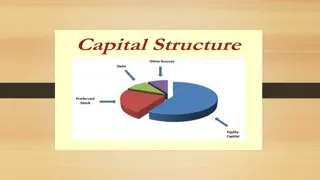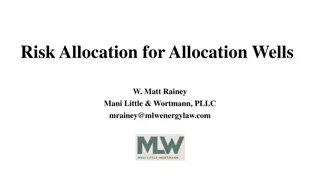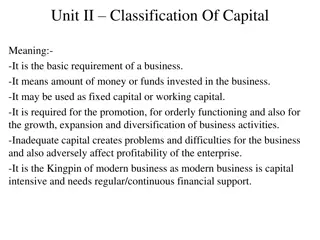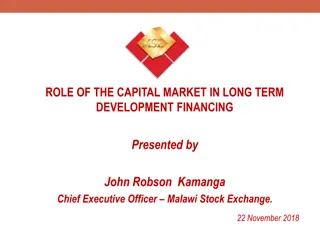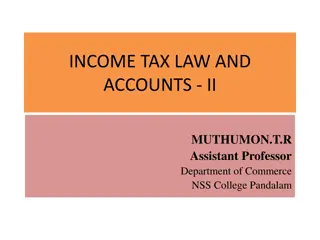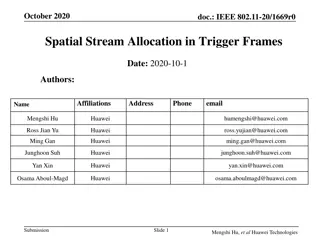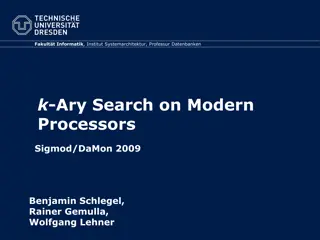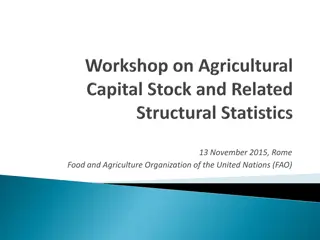In search of Lost Development: Industrial Decline and Capital Allocation
Analysis of the declining industrial sector's contribution to GDP in Brazil and its impact on productivity, with comparisons to international standards. Insights on the normalization process and implications for economic development.
Download Presentation

Please find below an Image/Link to download the presentation.
The content on the website is provided AS IS for your information and personal use only. It may not be sold, licensed, or shared on other websites without obtaining consent from the author.If you encounter any issues during the download, it is possible that the publisher has removed the file from their server.
You are allowed to download the files provided on this website for personal or commercial use, subject to the condition that they are used lawfully. All files are the property of their respective owners.
The content on the website is provided AS IS for your information and personal use only. It may not be sold, licensed, or shared on other websites without obtaining consent from the author.
E N D
Presentation Transcript
Seminrio: Em busca do desenvolvimento perdido Roberto Ellery Jr, ECO/FACE/UnB
Desindustrializao e m alocao de capital Queda na participa o da ind stria no PIB Ind stria e produtividade M aloca o de capital
Queda na participao da indstria no PIB Os dados analisados sugerem que em 1980 a participa o da manufatura do PIB era muito alta se considerados padr es internacionais. Hoje a participa o da manufatura do PIB no Brasil um pouco abaixo da m dia dos pa ses analisados e dos pa ses da Am rica Latina e Caribe. A forte redu o da participa o da manufatura do PIB que ocorreu no Brasil (e na Argentina) pode ser uma volta ao normal .
Indstria e produtividade O Brasil em Compara es Internacionais de Produtividade: Uma An lise Setorial. Fernando Veloso, Silvia Matos, Pedro Cavalcanti Ferreira e Bernardo Coelho. Em: Anatomia da Produtividade no Brasil. Regis Bonelli, Fernando Veloso e Armando Castelar Pinheiro (org). Elsevier. Socio Economic Accounts (SEA). World Input-Output Database (WIOD) 70% da SEA s o pa ses europeus World Table (PWT), vers o 8.1, para PPP agregada Dados de PPP para o setor de servi os do Groningen Growth and Development Centre Productivity Level Database
Indstria e produtividade A an lise revela que, embora a produtividade do Brasil possa aumentar se nossa aloca o setorial de trabalho se aproximar da observada nos pa ses desenvolvidos, os ganhos potenciais s o muito maiores caso nossa produtividade setorial convirja para o n vel observado nessas economias.
Indstria e produtividade The Textbook Case for Industrial Policy: Theory Meets Data. Dominick Bartelme, Arnaud Costinot, Dave Donaldson, Andres Rodriguez-Clare. Agosto, 2019. The textbook case for industrial policy is well understood. In sectors subject to external economies of scale, private marginal costs of production are lower than social ones. This creates a rationale for Pigouvian subsidies equal to the difference between the two, with the associated welfare gains equal to the area of the Harberger triangle located between the demand and social marginal cost curves. ( ) A major source of skepticism about industrial policy is that governments simply do not know which sectors should be subsidized at the expense of others. In this paper, we have focused on the textbook case for industrial policy, in which the rationale for such policy arises from the existence of external economies of scale; we have shown how, in this environment, one can use commonly available trade and production data to estimate economies of scale at the sector-level; and, in turn, we have characterized the structure and consequences of optimal industrial policy. Our baseline results are humbling. Empirically, we find that sector-level economies of scale indeed exist and do differ substantially across sectors, ranging from an elasticity of 0.07 to 0.25. Yet, even under our optimistic assumption that governments maximize welfare and have full knowledge of the underlying economy, our baseline analysis points towards gains from optimal industrial policy that are, on average across all countries, equal to just 0.69% of GDP, and only amount to 1.36% for the country that gains the most. These modest gains from industrial policy are slightly smaller than the average gains from optimal trade policy alone, which are equal to 0.95% of GDP.
M alocao de capital Studying the experience of countries that have experienced great depressions during the 20th century teaches us that massive public interventions in the economy to maintain employment and investment during a financial crisis can, if they distort incentives enough, lead to a great depression. Those who try to justify the sorts of Keynesian policies implemented by the Mexican government in the 1980s and the Japanese government in the 1990s often quote Keynes (1924) dictum from A Tract on Monetary Reform: The long run is a misleading guide to current affairs. In the long run we are all dead. Studying past great depressions turns this dictum on its head: If we do not consider the consequences of policy for productivity, in the long run we could all be in a great depression. Timothy Kehoe e Gonzalo Fern ndez de C rdoba
M alocao de capital Policy distortions and aggregate productivity with heterogeneous establishments. Diego Restuccia e Richard Rogerson. Review of Economic Dynamics, 2008. We formulate a version of the growth model in which production is carried out by heterogeneous establishments and calibrate it to US data. In the context of this model we argue that differences in the allocation of resources across establishments that differ in productivity may be an important factor in accounting for cross-country differences in output per capita. In particular, we show that policies which create heterogeneity in the prices faced by individual producers can lead to sizeable decreases in output and measured total factor productivity (TFP) in the range of 30 to 50 percent. We show that these effects can result from policies that do not rely on aggregate capital accumulation or aggregate relative price differences. More generally, the model can be used to generate differences in capital accumulation, relative prices, and measured TFP.
M alocao de capital Misallocation and manufacturing TFP in China and India. Chang-Tai Hsieh e Peter Klenow. Quarterly Journal of Economics, 2009. Resource misallocation can lower aggregate total factor productivity (TFP). We use microdata on manufacturing establishments to quantify the potential extent of misallocation in China and India versus the United States. We measure sizable gaps in marginal products of labor and capital across plants within narrowly defined industries in China and India compared with the United States. When capital and labor are hypothetically reallocated to equalize marginal products to the extent observed in the United States, we calculate manufacturing TFP gains of 30% 50% in China and 40% 60% in India.
M alocao de capital Misallocation and manufacturing TFP in China and India. Chang-Tai Hsieh e Peter Klenow. Quarterly Journal of Economics, 2009. For example, imagine an economy with two firms that have identical technologies but in which the firm with political connections benefits from subsidized credit (say from a state-owned bank) and the other firm (without political connections) can only borrow at high interest rates from informal financial markets. Assuming that both firms equate the marginal product of capital with the interest rate, the marginal product of capital of the firm with access to subsidized credit will be lower than the marginal product of the firm that only has access to informal financial markets. This is a clear case of capital misallocation: aggregate output would be higher if capital was reallocated from the firm with a low marginal product to the firm with a high marginal product. The misallocation of capital results in low aggregate output per worker and TFP.
M alocao de capital Misallocation and manufacturing TFP in China and India. Chang-Tai Hsieh e Peter Klenow. Quarterly Journal of Economics, 2009. Many institutions and policies can potentially result in resource misallocation. For example, the McKinsey Global Institute (1998) argues that a key factor behind low productivity in Brazil s retail sector is labor-market regulations driving up the cost of labor for supermarkets relative to informal retailers. Despite their low productivity, the lower cost of labor faced by informal-sector retailers makes it possible for them to command a large share of the Brazilian retail sector. Lewis (2004) describes many similar case studies from the McKinsey Global Institute.
M alocao de capital Misallocation and manufacturing TFP in China and India. Chang-Tai Hsieh e Peter Klenow. Quarterly Journal of Economics, 2009. In this section we relate TFPR dispersion in China to state ownership of plants, and TFPR dispersion in India to licensing and size restrictions. Na China os autores encontram rela o entre empresas estatais (menos produtivas) e a dispers o da produtividade, essa rela o desaparece em 2005 em parte por conta da redu o da import ncia das estatais (29% em 1998 e 8% em 2005) e em parte pelo aumento da produtividade das estatais sobreviventes. Na ndia os autores encontram rela o entre dispers o de produtividade e regras de licenciamento e limites de tamanho para empresas.
M alocao de capital Misallocation in the Brazilian manufacturing sector, Rafael Vasconcelos, Brazilian Review of Econometrics, v.37, n.2, 2017. According to this figure, the misallocation falls between 1996 and 2005 and then tends to grow. This pattern is observed in both specifications. In 2005, the lowest year of misallocation, the product is 44.7% farther from the product efficient when using U.S. Industry Share. When we use the Firm- Specific Share, this distance is 54.3%. Thus, an efficient reallocation in times of lower misallocation in the Brazilian manufacturing sector will result in the approximately doubling of the aggregate product. This effect was even greater after 2005.
M alocao de capital Rafaela Bastidas & Nicol s Acosta, 2019. "Misallocation and manufacturing TFP in Ecuador: formal, semi-formal and informal firms," Journal of Economic Structures, Springer;Pan-Pacific Association of Input-Output Studies (PAPAIOS), vol. 8(1), pages 1-29, December. Laiqun Jin & Changwei Mo & Bochao Zhang & Bing Yu, 2018. "What Is the Focus of Structural Reform in China? Comparison of the Factor Misallocation Degree within the Manufacturing Industry with a Unified Model," Sustainability, MDPI, Open Access Journal, vol. 10(11), pages 1-19, November. Wu, Guiying Laura, 2018. "Capital misallocation in China: Financial frictions or policy distortions?," Journal of Development Economics, Elsevier, vol. 130(C), pages 203-223. Doan Thi Thanh Ha & Kozo Kiyota, 2015. "Misallocation, Productivity, and Trade Liberalization: The Case of Vietnamese Manufacturing," Keio-IES Discussion Paper Series 2015-007, Institute for Economics Studies, Keio University. Sangeeta Pratap & Carlos Urrutia & Felipe Meza, 2014. "Credit, Misallocation and TFP: The case of Mexico (2003-2010)," 2014 Meeting Papers 701, Society for Economic Dynamics. D Erasmo, Pablo N. & Moscoso Boedo, Hernan J. & enkal, Asl , 2014. "Misallocation, informality, and human capital: Understanding the role of institutions," Journal of Economic Dynamics and Control, Elsevier, vol. 42(C), pages 122-142. Ezra Oberfield, 2013. "Productivity and Misallocation During a Crisis: Evidence from the Chilean Crisis of 1982," Review of Economic Dynamics, Elsevier for the Society for Economic Dynamics, vol. 16(1), pages 100-119, January.
Resumo Ocorreu uma queda significativa na participa o da ind stria de transforma o no PIB no Brasil desde 1980, poss vel que esse movimento tenha sido um retorno ao normal . Realoca o setorial de m o de obra pode aumentar a produtividade do trabalho no Brasil, mas os efeitos dessa realoca o s o bem mais modestos do que melhorias na produtividade. N o f cil estabelecer rela o de causalidade entre participa o da ind stria de manufatura no PIB e crescimento, mais dif cil ainda avaliar o impacto de pol ticas industriais no crescimento. Trabalho recente discutido na apresenta o sugere que o efeito modesto. M aloca o de capital pode ter um papel significativo para explicar baixo desempenho da produtividade. No lugar de pol ticas de incentivos/subs dios/prote o a solu o da m aloca o de capital est mais relacionada com reformas.
Obrigado! Roberto Ellery Jr http://rgellery.blogspot.com.br/








